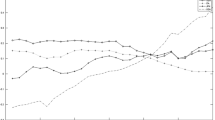Abstract
This paper applies the panel fixed effects with vector decomposition estimator to three FDI data sets to estimate the impact of time-invariant variables on FDI while including fixed effects. We find that the omission of fixed effects significantly biases the results, leading to contradictory predictions regarding the effect of trade costs and culture across data sets. After eliminating these biases, the differences across data sets largely disappear and many time-invariant variables consistently indicate the importance of vertical FDI. This suggests that some controversies in the literature may be driven by the extent to which unaccounted fixed effects biases vary across different data sets.
Similar content being viewed by others
References
Baltagi, B. H., P. Egger, and M. Pfaffermayr (2007). Estimating Models of Complex FDI: Are There Third-Country Effects? Journal of Econometrics 140 (1): 260–281.
Barro, R. J., and J. W. Lee (2001). International Data on Educational Attainment: Updates and Implications. Oxford Economic Papers – New Series 53 (3): 541–563.
Bergstrand, J. H., and P. Egger (2008). A Knowledge-and-Physical-Capital Model of International Trade Flows, Foreign Direct Investment, and Multinational Enterprises. Journal of International Economics 73 (2): 278–308.
BERI (Business Environment Risk Intelligence) (2007). Available at <www.beri. com>.
Blonigen, B. A. (2005). A Review of the Empirical Literature on FDI Determinants. Atlantic Economics Journal 33 (4): 383–403.
Blonigen, B. A., and R. B. Davies (2004). The Effects of Bilateral Tax Treaties on US FDI Activity. International Tax and Public Finance 11 (5): 601–622.
Blonigen, B. A., R. B. Davies, G. R. Waddell, and H. Naughton (2007). FDI in Space: Spatial Autoregressive Relationships in Foreign Direct Investment. European Economic Review 51 (5): 1303–1325.
Brainard, S. L. (1997). An Empirical Assessment of the Proximity-Concentration Trade-Off between Multinational Sales and Trade. American Economic Review 87 (4): 520–544.
BEA (Bureau of Economic Analysis) (2007). Available at <www.bea.doc.gov/bea/di/di1fdibal.htm>.
Carr, D. L., J. R. Markusen, and K. E. Maskus (2001). Estimating the Knowledge-Capital Model of the Multinational Enterprise. American Economic Review 91(3): 693–708.
Carr, D. L., J. R. Markusen, and K. E. Maskus (2003). Estimating the Knowledge-Capital Model of the Multinational Enterprise: Reply. American Economic Review 93 (3): 995–1001.
Coughlin, C. C., J. V. Terza, and A. Vachira (1991). State Characteristics and the Location of Foreign Direct Investment within the United States. Review of Economics and Statistics 73 (4): 675–683.
Davies, R. B. (2008). Hunting High and Low for Vertical FDI. Review of International Economics 16 (2): 250–267.
di Giovanni, J. (2005). What Drives Capital Flows? The Case of Cross-Border M&A Activity and Financial Deepening. Journal of International Economics 65 (1): 127–149.
Eaton, J., and A. Tamura (1994). Bilateralism and Regionalism in Japanese and US Trade and Direct Foreign Investment Patterns. Journal of the Japanese and International Economies 8 (4): 478–510.
Ekholm, K., R. Forslid, and J. R. Markusen (2007). Export-Platform Foreign Direct Investment. Journal of European Economics Association 5 (4): 776–795.
Gao, T. (2005). Foreign Direct Investment in China: How Big Are the Roles of Culture and Geography? Pacific Economic Review 10 (2): 153–166.
Gbetnkom D. (2006). On the Empirics of Market Integration in ECOWAS. Journal of Policy Reform 9 (4): 289–303.
Grubert, H., and J. Mutti (2004). Empirical Asymmetries in Foreign Direct Investment and Taxation. Journal of International Economics 62 (2): 337–358.
Head, K., and J. Ries (2005). Judging Japan’s FDI: The Verdict from a Dartboard Model. Journal of the Japanese and International Economies 19 (2): 215–232.
Helpman, E. (1984). A Simple Theory of International Trade with Multinational Corporations. Journal of Political Economy 92 (3): 451–471.
Hofstede, G. (1980). Culture’s Consequences. New York: Sage.
Hofstede, G. (2001). Culture’s Consequences: Comparing Values, Behaviors, Institutions, and Organizations across Nations. New York: Sage.
Hofstede, G., and M. H. Bond (1988). The Confucius Connection: From Cultural Roots to Economic Growth. Organizational Dynamics 16 (4): 4–21.
Ionaşcu, D., K. E. Meyer, and S. Estrin (2006). The Impact of Institutional and Resource Distance on International Entry Strategies. Working Paper.
Janeba, E. (2007). International Trade and Consumption Network Externalities. European Economic Review 51 (4): 781–803.
Lipsey, R. E. (2006). Measuring the Impacts of FDI in Central and Eastern Europe. NBER Working Paper 12808. National Bureau for Economic Research, Cambridge, Mass.
Markusen, J. R. (1984). Multinationals, Multi-Plant Economies, and the Gains from Trade. Journal of International Economics 16 (3–4): 205–226.
Markusen, J. R. (2002). Multinational Firms and the Theory of International Trade. Cambridge and London: MIT Press.
Markusen, J. R., and K. E. Maskus (2002). Discriminating among Alternative Theories of the Multinational Enterprise. Review of International Economics 10 (4): 694–707.
OECD (Organization for Economic Cooperation and Development) (2007). International Direct Investment Statistic. CD-ROM version.
Plümper, T., and V. E. Troeger (2007). Efficient Estimation of Time-Invariant and Rarely Changing Variables in Finite Sample Panel Analyses with Unit Fixed Effects. Political Analysis 15 (2): 124–139.
Rose, A. K. (2004). Do We Really Know That the WTO Increases Trade? American Economic Review 94 (1): 98–114.
Tihanyi, L., D. A. Griffith, and C. J. Russel (2005). The Effect of Cultural Distance on Entry Mode Choice, International Diversification, and MNE Performance: A Meta-Analysis. Journal of International Business Studies 36 (3): 270–283.
Tong, S. Y. (2005). Ethnic Networks in FDI and the Impact of Institutional Development. Review of Development Economics 9 (4): 563–580.
US (United States Government Printing Office) (2007). Economic Report to the President. Washington, D.C.
WDI (World Development Indicators) (2007). Available at <http://publications.worldbank.org/WDI/>.
Yeaple, S. R. (2003). The Complex Integration Strategies of Multinationals and Cross Country Dependencies in the Structure of Foreign Direct Investment. Journal of International Economics 60 (2): 293–314.
Author information
Authors and Affiliations
Corresponding author
Additional information
JEL no.
F14, F23
About this article
Cite this article
Davies, R., Ionascu, D. & Kristjánsdóttir, H. Estimating the Impact of Time-Invariant Variables on FDI with Fixed Effects. Rev World Econ 144, 381–407 (2008). https://doi.org/10.1007/s10290-008-0153-0
Issue Date:
DOI: https://doi.org/10.1007/s10290-008-0153-0




